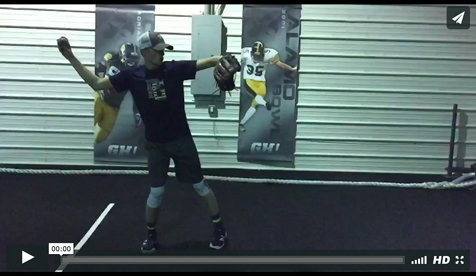
Learn what ‘good mechanics’ really look like (if you want to avoid Tommy John surgery).
We hear the phrase ‘good mechanics’ all the time in the baseball community. Here’s a look at what ‘good mechanics’ actually looks like if you want healthy elbows. (I suggest you review this post on ‘bad mechanics’ before watching the clip below.)
I’m going to take you on a brief expedition into real mechanics. You will need to play the movie below multiple times for each point I detail below. Focus on each point one at a time. Welcome to my world and the world of meaningful mechanics evaluation! As you start understanding the sequence I’m going to show you, your world view will change.
You’re going to be watching a 19 second clip — the time it takes to slow things down and watch less than one second worth of real time. This student is throwing a one pound ball, at maximum intensity, using a drill I use in the teaching process. DO NOT try this at home. This drill requires very specific instruction and specific technique. If you screw up you could hurt yourself. Yes, I know weighted balls are controversial, but once you understand that throwing something heavy can actually help you discover ideal technique I think you’ll change your mind.
- Hint: you can grab the video slider bar and slow this down even more.
- As you play the clip the first time you’ll notice that the lights flicker. High speed imagery (you might call it slow motion) reveals that the lights in this facility are turning on and off about 240 times every second. In facilities like this I ask observers and players if the lights are on. They always say, ‘yes.’ The human eye takes about 30 snapshots every second and the brain blends the motion together. Takeaway: sometimes what we think we see is different from what’s actually happening.
- Play the clip again and get a general sense of what everything looks like.
- This time, play the clip and focus only on the ball. Once it starts moving forward you’ll notice that the ball never stops forward movement. This single characteristic dramatically changes stress on the elbow. You’ll also note that the forward movement of the ball has very limited upward and downward movement. Takeaway: in the world of physics this limited vertical displacement is also very efficient.
- Play the clip again and focus only on the glove. At about 12 seconds, once the stride foot (left foot) starts to plant and block, watch how the glove pulls back uninterrupted. Takeaway: an uninterrupted glove side fuels continuous rotation of the torso.
There’s a whole lot more, and it all matters. From this single side view I’m observing about a dozen movements, each as detailed as items 3 & 4 above, how they are sequenced together, and the timing of everything as a whole. When I conduct a complete evaluation with new students, or when we start training again after a competitive season, we go through imagery like this together. The process of evaluating takes a couple hours because it’s important to build a mental three-dimensional picture of what the body is actually doing, using both side views and front or rear views.
It takes high speed imagery to see what’s really true about pitching mechanics. Then you have to know what you’re really observing. Finally, and most importantly, you have to know how to fix the problems. Let me teach you how to do this for yourself, your son, or your players.
If you love baseball or a baseball player, please share my blog.
